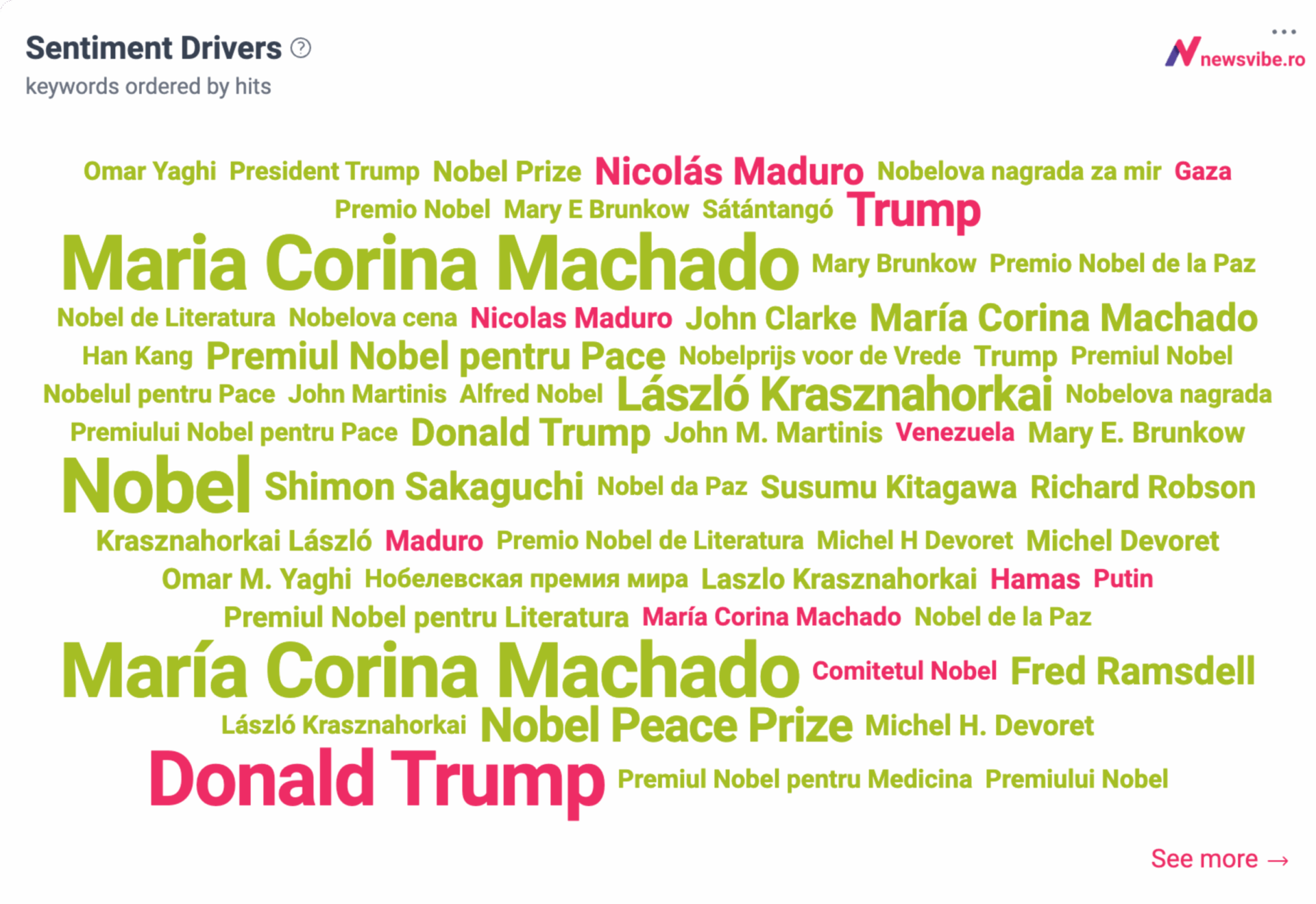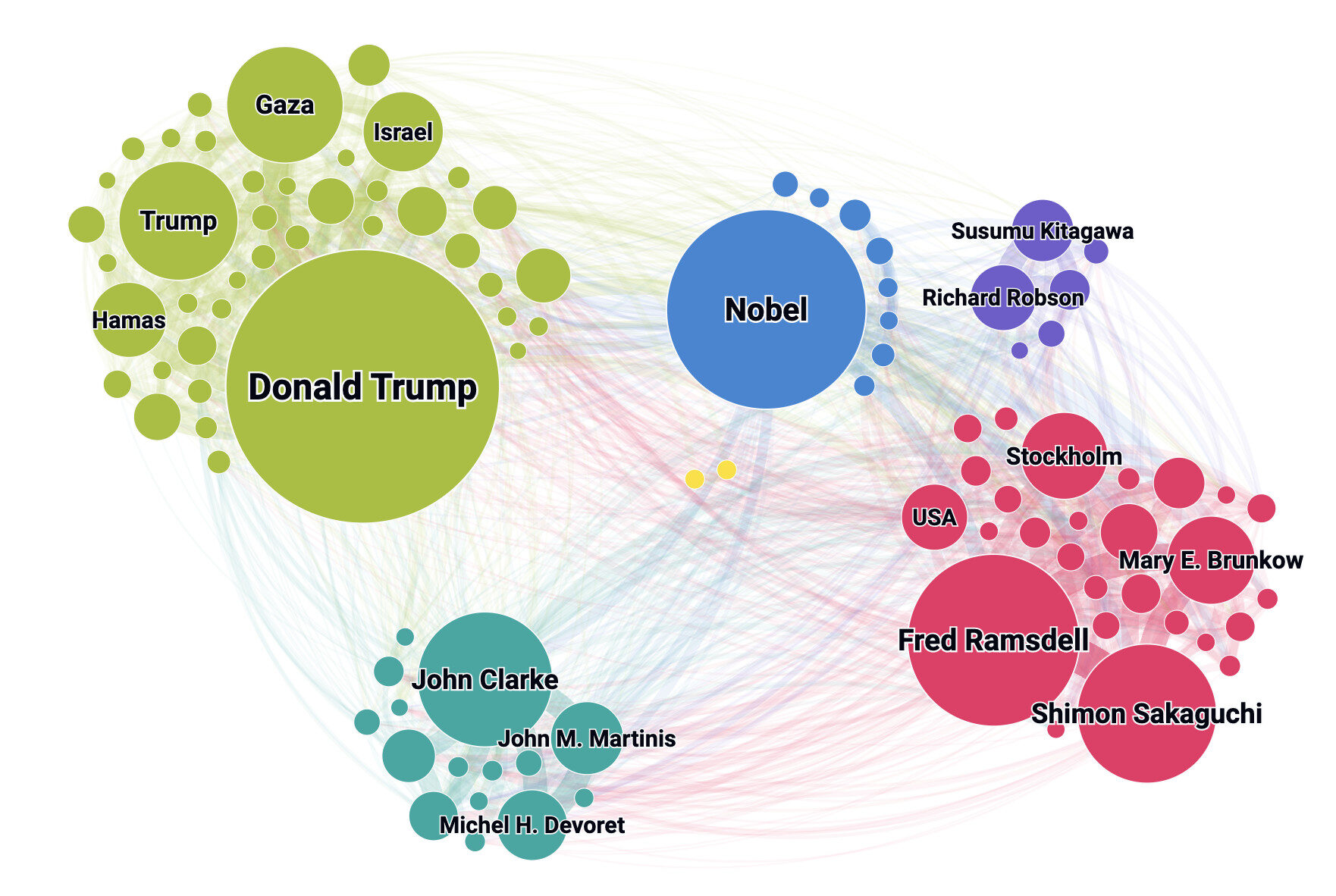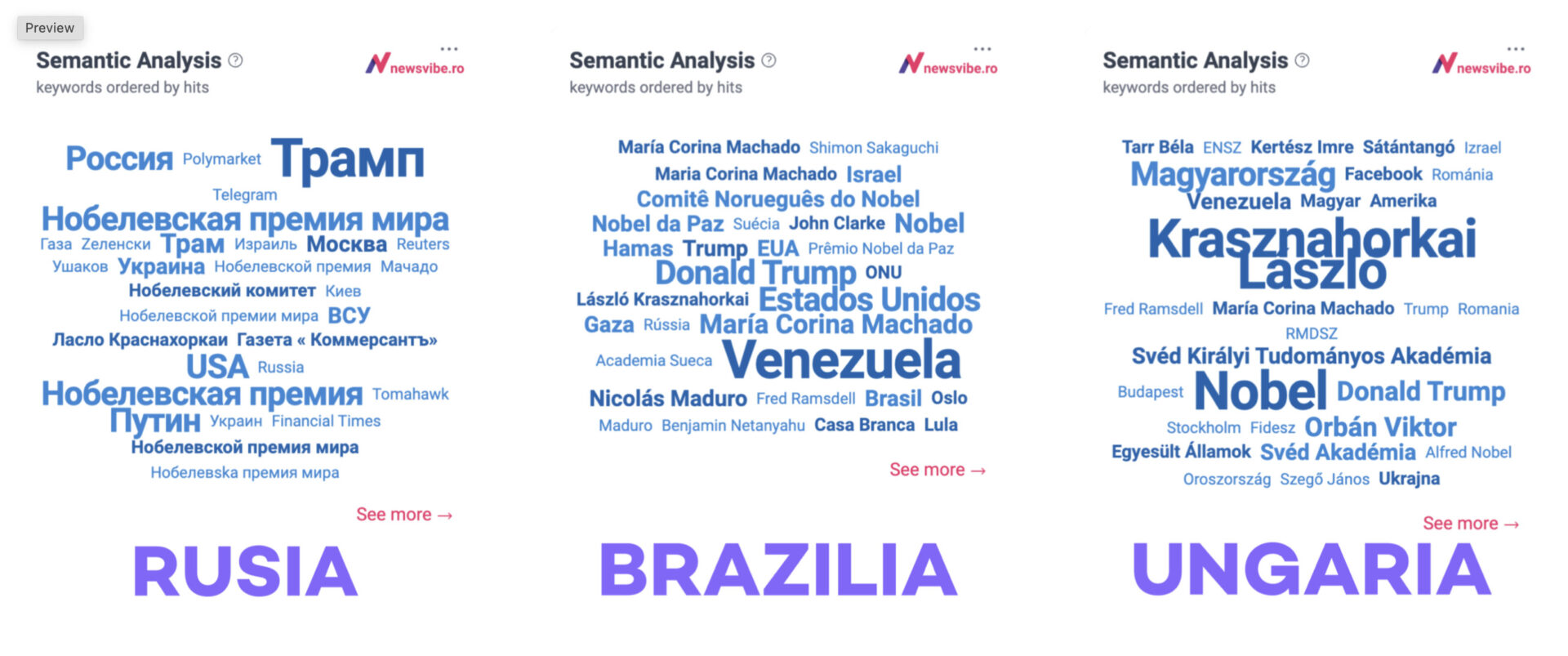Politics vs Science: who are the true emotional drivers in global discussions
The first clear conclusion is that the emotion and polarization surrounding the Nobel Prize are not generated by the laureates themselves. Using NewsVibe’s entity-level sentiment analysis feature, we identified the public figures and topics that triggered the strongest sentiment – positive (green) or negative (red) – in the global conversation. The size of each term in the word cloud reflects its frequency of mention.

The entity-level sentiment analysis clearly shows that the discussion is dominated by political figures. The most prominent sentiment drivers are:
- Donald Trump: Frequently mentioned in a negative context (red), this name stands out as the main driver of polarization, reflecting the strong media interest in controversies surrounding the Nobel Peace Prize and the American president’s comments on the topic.
- María Corina Machado: Another major sentiment driver, but mentioned predominantly in a positive context (green). The 2025 Nobel Peace Prize laureate’s name confirms that the global conversation is centered on this topic to a far greater extent than on others.
- Although far less visible than the political figures, several laureates in the scientific and literary fields can be identified, appearing almost exclusively with a positive connotation (green): László Krasznahorkai, John Clarke, Shimon Sakaguchi, Mary E. Brunkow, Susumu Kitagawa and Richard Robson. They are the “silent heroes” of the conversation. Despite being the official reason for the event, they generate a low volume of discussion and virtually no polarization. Their presence, though discreet, is important in highlighting the stark contrast with the political dimension of the topic.
In essence, the emotional energy of the global conversation is channeled toward politics and conflict, leaving scientific and literary achievements in the background.
The conversation map: visualizing the connections between entities
- The turquoise cluster (quantum physics): the group formed by John Clarke, Michel H. Devoret and John M. Martinis.
- The red cluster (immunology): the conversation surrounding the Nobel Prize in Medicine laureates – Mary E. Brunkow, Fred Ramsdell and Shimon Sakaguchi.
- The purple cluster (chemistry): the Chemistry Prize laureates, Susumu Kitagawa and Richard Robson, form the smallest and most isolated cluster – an indicator of a niche, more technical debate, less connected to the broader public discourse.
A clear divide can be observed between the political conversation – large in volume and emotionally charged – and the niche discussions focused on scientific merit.

Local perspectives: how the debate looks from Hungary, Brazil, and Russia
- In HUNGARY: national pride and a focus on the Nobel Prize in Literature. Here, the conversation is clearly dominated by writer László Krasznahorkai, this year’s laureate.
- In BRAZIL: focus on Venezuela. The discussion revolves around Venezuelan figure María Corina Machado, the Nobel Peace Prize laureate, and her home country – reflecting a clear interest in South American geopolitical dynamics.
- In RUSSIA: the Peace Prize seen through a geopolitical lens. In Russian-language sources, the conversation is overwhelmingly tied to the war in Ukraine. Entities such as Трамп (Trump), Путин (Putin) and Украина (Ukraine) are central. The Nobel Peace Prize (Нобелевская премия мира) serves as a framework for a geopolitically charged discussion, further fueled by Russian President Putin’s comments on his American counterpart’s peace efforts. A special mention goes to the entity ВСУ (Armed Forces of Ukraine), which appears in the conversation through remarks such as “the Nobel Prize in Literature was awarded for glorifying the Ukrainian Armed Forces and hatred toward Orbán” or “the American president might receive the Nobel Peace Prize for supplying weapons.”

Strategic implications: what do these data mean?
For any brand, institution, or public figure, this analysis demonstrates several essential principles:
- Tone is just as important as topic. It is not enough to know what is being talked about, but also how it is being talked about. Identifying sentiment drivers enables a quick understanding of the sources of negativity or positivity.
- Context is essential. The same topic (the Nobel Prizes) resonates completely differently depending on the geographical and political context. Any national or international communication campaign must be adapted to these local nuances.
- Data visualization accelerates understanding. Tools such as sentiment analysis and entity networks transform massive volumes of data (“noise”) into clear insights.
By decoding these layers of conversation, NewsVibe provides the clarity needed to navigate a complex media landscape and to make decisions based on data, not assumptions.
What was, in brief, the main topic of discussion surrounding the 2025 Nobel Prizes?
Our analysis reveals a fragmented conversation. On one hand, a massive, polarized political debate dominated by Donald Trump and geopolitical conflicts; on the other, a series of much smaller, niche discussions focused on the scientific merits of the laureates.
Why was Donald Trump so visible in this conversation?
His visibility was not tied to winning a prize but to comments and the intense media debates over his potential win, and consequent loss, of the Nobel Peace Prize. This context turned the topic into a vehicle for broader discussions about the conflicts in Gaza and Ukraine and his role in peace efforts.
How does such an analysis help a brand or organization?
This analysis shows that real public perception can differ greatly from an event’s official communication. For a brand, understanding these underlying structures of the conversations is essential to accurately calibrate its messaging, anticipate reputation risks and adapt its communication strategy to each country’s specific cultural and political context.
